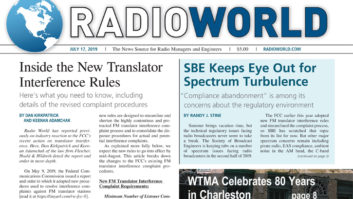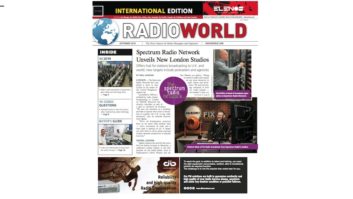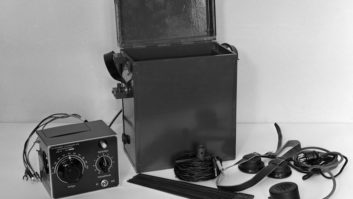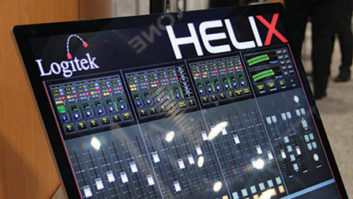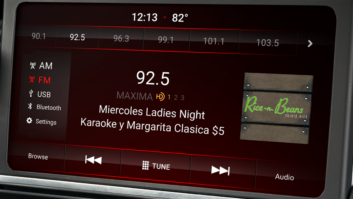The author is owner of Kline Consulting and former corporate director of engineering and broadcast IT for several radio companies.
The large choice of codecs available on the market can be overwhelming. Here are some important points managers should take into consideration when defining their audio transport strategy and shopping for new gear.

-
In today’s terms, does everyone on the team understand what a codec is and how it is used?
This might seem like a basic question that anyone can answer; but often, depending on the person you ask, the definition will vary. Years ago, we thought of a codec as a simple singular compression and decompression scheme or device. But the term “codec” has taken on a more general definition, which can sometimes be interchanged with STL, microwave, transmission path, etc. So before you go down the path of integrating new codec technology into your facility, make sure everyone on the team is familiar with the current models and configurations of the codecs on the market. Codecs today comprise many technologies and come in various sizes, shapes and price tags.
-
Is this a simple codec replacement project or something bigger in scope?
In my consulting practice, I meet many managers who start off by asking about a simple codec recommendation. By the time we finish talking, we both realize that there is a bigger picture to consider involving several codec brands and models. By asking the right questions and walking through the technical workflow of the building, we learn that there are pending, among other things, STL, remote broadcast and even on-air telephone system needs, all of which could involve codec purchases. So before the codec selection and quoting process begins, ask yourself whether this is a limited scope project or something broader. You may save money and increase efficiency on your capital spend by reviewing the larger picture up front.
-
If this is a broader physical plant codec review, have you defined your goals and requirements?
Defining your requirements goes together with the above question. Without specific goals, how can you determine whether a codec makes sense for a particular situation?
Obviously, a simple remote broadcast codec solution is easy to determine. But a larger, sophisticated codec upgrade and replacement project does require you to identify your goals and requirements.
Some requirements might include:
- cost savings over telecom fees
- audio quality
- increased density so that multiple audio channels can be accommodated with lower cost
- improved workflow
- redundancy against existing legacy audio transport, metadata and control
- integration into AES67/AoIP/Dante infrastructure
- cost savings over non-codec/IP solutions
- reduced maintenance requirements
- interoperability/interconnectivity within the plant or third-party studios
- portability in the field
- integration (or replacement) of on-air phone systems
- additional methods for listener interaction (using mobile apps, etc.)
Those are just a few examples. Any of these requirements can be combined into a matrix to help determine if or when a codec purchase should be made.
-
I don’t trust my audio to the public internet for delivery. Is that a valid concern?
Ten years ago, many engineers had their doubts about the reliability of using IP codecs for critical audio applications over the public internet. At the time, they might have considered using the public internet as a backup path only. This was due to internet speed, reliability, cost and a lack of availability at rural locations, such as transmitter sites.
One could have ordered dedicated point-to-point IP circuits, but 10 years ago those costs were much higher than they are today. Also, some codec models didn’t have a redundant second carrier or aggregation option which meant everything had to rely on a single internet provider.
Today, however, public internet generally is reliable and can be ordered as a business class service with higher speeds. It is usually inexpensive and is available in more places including rural transmitter sites.
Most codec units on the market now — including single remote broadcast units — have options for integrating and aggregating multiple carriers, which make using the public internet safe and reliable. A number of codec installs using the public internet have been installed with few problems. In some very high-profile mission critical situations, I have ordered a point-to-point Ethernet circuit to be used as the primary carrier with a public internet line as the second carrier. Dedicated Ethernet circuits guaranteeing increased supervision by the carrier are a lot less expensive today. So if having a dedicated circuit is a mandate for you, like a traditional T1, this is absolutely possible.
Broadcasters use a combination of public internet, point-to-point Ethernet, MPLS and RF to connect their codecs.
[Read: How to Cover Live Events Successfully]
-
Can a codec operate using RF?
Yes. Typically, a data radio is used at each end, which provides a private Ethernet path for the station between two points (typically between the studio and the transmitter site). This allows for audio transport, metadata, Ethernet and remote monitoring.
The RF data radios are usually bidirectional, as are the codecs, so return audio can be passed back to the studio for confidence monitoring, etc. The RF path physical distance can be short or go for several miles.
There are different radio models with different costs depending how much bandwidth is needed and how far the transmission path is. For shorter distances, these radios utilize smaller dishes. If a proper path is designed and the appropriate radio/antenna combination is selected, the RF system will be very reliable. Some systems can be installed without a license from the spectrum regulatory body and in other cases may require one.
The cost to implement an RF link for codec usage is very competitive compared to traditional analog microwave gear, in some cases much less expensive.
-
Are there any new practical codec technologies?
Yes. Here are some of the features you’ll find in codecs today: AES67 and Dante compatibility, AoIP compatibility with console manufacturers, transport of FM MPX composite over IP, higher-density transport containing multiple audio channels using the same piece of hardware, smaller physical sizes, carrier aggregation for redundancy and improved connection reliability, improved usage of cellular including 4G LTE and easy-to-understand GUIs.
In addition, most units now feature integration with on-air phone systems for improved caller audio, iOS and Android apps for remotes and news gathering as well as enhanced listener and VIP participation, reduction in cost per audio channel, and cloud-based switchboard servers to make connecting codecs even easier by eliminating certain firewall or router issues.
The FM MPX over IP feature is very helpful to those who wish to move their audio processing back to the studio or for those who want one audio processor to feed multiple locations. MPX over IP may also be interesting to those who employ SFNs.
Apps for the smartphone or laptop make remotes, newsgathering and listener call-ins sound better and are easy to implement. Cellular bonding makes broadcasting from rural areas and large events (concerts, sports) more reliable because it helps mitigate network congestion.
-
Are there advantages to having an AoIP plant as it relates to codecs?
Yes. There are several codec boxes today that are compatible with AoIP consoles and audio routing systems. This allows for high-density audio paths without all the extra wiring.
A well-designed AoIP plant will incorporate seamless integration into the switching and control aspect of all installed codecs. For example, a large complex with many studios can use just a handful of codecs by utilizing dynamic allocation and switching available within an AoIP system. This saves on the expense of purchasing more codecs than otherwise might be needed.
AoIP also allows for the automatic control and manipulation of codecs for linking remote studios together or to send programs from one city to another. The macros and automation available in a typical AoIP infrastructure can tie together the features of your automation playout system, console routing and codec allocation to facilitate very powerful audio transport within your plant or to the outside world. Modern radio distribution networks are being built around this concept. IP codecs are increasingly being used for program backhaul, satellite replacement, and regular program distribution at great cost savings and efficiencies.
-
Besides the purchase of the codec equipment, what other technical matters should be considered?
There are a few key ones.
One is your firewall. Codecs that talk to other devices in the outside world need a way to get through your firewall. Each codec has its own set of ports and special routing requirements so they can connect reliably to the far end. The requirements are not complicated, but someone with knowledge of firewalls and routers will need to manage this. The use of cloud-based switchboard/transversal servers can eliminate some or all of this, so they are a good option.
You should also consider redundancy for mission-critical paths. This is good practice whether you are using a codec or any other type of transport device. One method is adding additional carriers for what is known as “carrier redundancy.” The other is physical hardware redundancy, which means you will have a second physical codec or legacy device in place to backup the primary codec.
Another key consideration is your internet provider. You should allow for enough bandwidth inside your facility to handle all the requirements not related to codec usage plus your total possible codec utilization.
Do not ignore your upload speeds; this is particularly important for codecs that are sending IFB audio to the field. Some facilities have installed a separate internet line solely for their codecs or to be used as a backup, although this is not absolutely required.
Every situation is unique, so it’s impossible to cover them all here. These are just a few of the more common approaches. The bottom line: Redundancy is good engineering practice in addition to having a well-designed IT infrastructure.
-
Do I need to be a scientist (or hire one) to install and program codecs?
No. The GUIs and setup screens in codecs today are easy enough to understand and navigate.
In addition, because IP codecs have been around for several years, there is a lot of institutional knowledge out there. It is easy to find someone on staff or locally who can assist with the programming and setup of any popular codec device.
There are also excellent online resources in the public user groups and on manufacturer websites. Most program directors and on-air talent regularly broadcast from the field using an IP codec without any technical assistance. Some codecs even allow for remote control so that someone back at the studio can diagnose minor issues in the field for an added measure of support.
-
I have a codec; which audio algorithm should I use?
Use the highest quality (least compressed) algorithm that will reliably work given your particular speed, network congestion and program material. In other words, choose for the best audio quality without risking dropouts or glitches.
Most codecs have settings to buffer and lock in a solid connection even under challenging situations, so don’t be afraid to start at the top and work your way down. Using more than one carrier simultaneously (aggregation) can improve robustness. Music programming usually requires higher quality while speech can get away with lower bandwidth in many cases.
Your codec manufacturer can walk you through the steps necessary to activate carrier aggregation.
